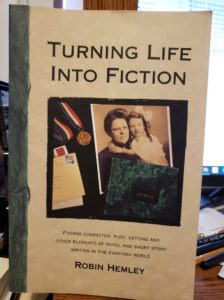
I have a fair number of books for writers in my library. I should read more of them, but, given the large number of books I’m working through, I tend to pick others over those. Recently, I browsed one of my bookshelves, the one tucked away in the storeroom, and pulled two out. I took them and no others on our recent trip to Texas, forcing me to read them.
On Wednesday I finished the first of them, Turning Life Into Fiction, by Robin Hemley. Since that’s what I do to a fairly great extent in my fiction, I thought this would be good to read. It was. I read the paperback edition, copyrighted 1994. My copy is a new book but I don’t remember buying it. Possibly I won it at a writers conference. That might sound old, but really it isn’t. The advice that Hemley gives works across the 90s and the 20s.
Take your life, or any part of real life, and figure out how to turn it into fiction. You aren’t writing history, and there’s no need to make your fiction exactly faithful to history. Begin with the truth. Add characters, delete characters, change the gender of characters. Start with the real setting; make some changes, but probably not as many as with the characters. But, if you change anything about a real place be prepared for someone very familiar with that place to call you out on it. That’s okay. For every 1 reader who knows the place you will have 1000 readers who don’t. So make a few changes. Maybe more than a few.
Hemley starts with journaling, and the importance of it, then moving on to memoir. He talks about the news and how to take virtually any news story and be able to develop a fictional story about it. He cautions the writer, however, that not every historical detail needs to be part of your memoir or story. The writer needs to take great care to see that the story has the right details, the details needed to pull in the reader and keep them reading.
The last chapter has to do with legal and ethical concerns. You don’t want to use real people in your books without permission. If you do, change enough so that the character bears only a little to the original. While successful lawsuits against fiction writers based on characters that resemble real people are rare, they do happen.
I’m glad I read this book. It helped me to see how I’m doing a lot of things right as I turn real life experiences into fiction. I’m not going to keep this book, as I never see myself re-reading it. But it’s a good book, a worthwhile read for any writer.